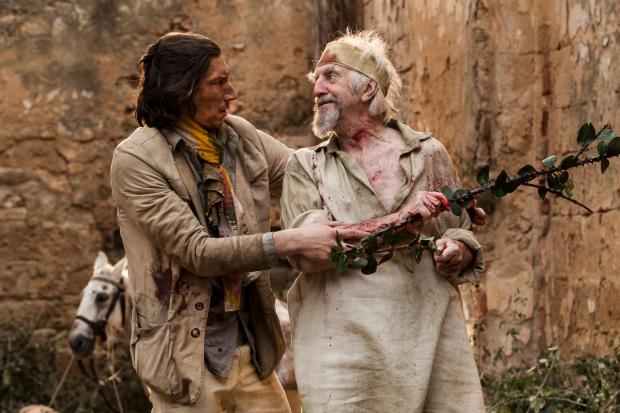Monty Python collaborator Terry Gilliam’s The Man Who Killed Don Quixote falls into an interesting motion picture category. Cinematic lore includes a sort of subgenre of “difficult” films often made by powerful directors seeking to impose their exacting, iconic, auteurish visions on studios, audiences, critics, etc. During the silent screen era the original uncut versions of D.W. Griffith’s 1916 Intolerance and Erich von Stroheim’s 1924 Greed reportedly unspooled with hours of endless footage. Sometimes these demanding directors’ dreamt-of masterpieces went unfulfilled - von Stroheim never completed his 1932 Queen Kelly starring Gloria Swanson (although, strangely, scenes from it are glimpsed in Billy Wilder’s 1950 Sunset Boulevard, where a washed up von Stroheim portrays the chauffeur Max, ex-star Swanson’s onetime helmer).
Orson Welles’ The Other Side of the Wind, which the “defrocked” director had begun in the 1970s, wasn’t put together and released until it found a home on Netflix in 2018, long after Welles’ death. Similarly, Welles’ intended iteration of Don Quixote, which he’d started shooting back in 1957 and he worked on, as time and funding permitted until his death in 1985, went unfinished. In 1992, a version edited by Jesús Franco, best known for directing horror movies, was finally released.
Gilliam should have learned from these cautionary tales, especially the latter, but the actor/writer/director of movies known for their wild, wacky sense of humor and extraordinary visual panache, such as 1975’s Monty Python and the Holy Grail, 1981’s Time Bandits and 1985’s Brazil, was hell-bent on making his own rendition of Miguel de Cervantes’ 1605 novel Don Quixote about lost chivalry, madness and more. Without going into detail, Gilliam began his quixotic quest back in 1989 and a series of failed attempts to film The Man Who Killed Don Quixote ensued, with stars such as Johnny Dep. Gilliam’s quixotic crusade to make his troubled productions even resulted in the 2002 documentary Lost in La Mancha.
Thirty years later, what’s now being released is a mildly amusing mishmash starring Adam Driver as Toby, an American filmmaker and advertising director abroad in Spain who’d previously directed a low budge indie version of Cervantes’ work. The Spanish cobbler he’d cast to portray the lead (Jonathan Pryce) about a decade earlier actually believes he is now, indeed, Don Quixote, and when he re-encounters Toby, that the helmer is his faithful squire, Sancho Panza.
Surreal adventures and would-be hilarious high jinks intended to be Python-esque ensue. Much of it is a jumble and tediously unfunny. But Gilliam’s much-vaunted cinematic eye captures exquisite images of the Portuguese, Canary Island and mostly Spanish locations and towards the end there is a great joust between Toby - who has become enraptured and sufficiently “quixoticized” - giants and, but of course, a windmill, that will call to mind Gilliam’s special effects extravaganzas in Brazil, et al, as well as that immortal visual effects visionary Ray Harryhausen.
Since HBO’s Girls, when his actor character somehow managed to survive Lena Dunham’s sheer creepiness, I happen to be an Adam Driver fan and was happy to see him in this leading role. I also enjoy watching the Welsh actor Jonathan Pryce, who BTW was in Gilliam’s Brazil, 1988’s The Adventures of Baron Munchausen and 2005’s The Brothers Grimm and has played the rather nasty religious fanatic High Sparrow on HBO’s Game of Thrones. Other cast members include Swedish thesp Stellan Skarsgård (2011’s The Girl With the Dragon Tattoo and Thor) and Ukrainian Olga Kurylenko, the Bond Girl in 2008’s Quantum of Solace.
I respect Terry Gilliam’s creativity, talent, perseverance and patience, but in all due respect, I’m not sure The Man Who Killed Don Quixote is worth the wait or all the effort. I suspect this exercise is mostly for diehard Gilliam and Cervantes fans, and diehard cinefiles. It seems that the definitive version of Cervantes’ elusive novel is yet to be filmed - while Dale Wasserman’s musical Man of la Mancha is stellar, the 1972 screen adaptation may have starred great actors (Peter O’Toole and Sophia Loren), but unfortunately, neither could sing. Who is next to try to film the saga of the errant Knight of the Woeful Countenance?
The Man Who Killed Don Quixote is being screened April 19-25 at the specialty theater Arena Cinelounge Sunset, 6464 Sunset Blvd., Hollywood, CA 90028.
L.A.-based reviewer/film historian Ed Rampell co-authored “The Hawaii Movie and Television Book” available at: https://mutualpublishing.com/product/the-hawaii-movie-and-television-book/.




